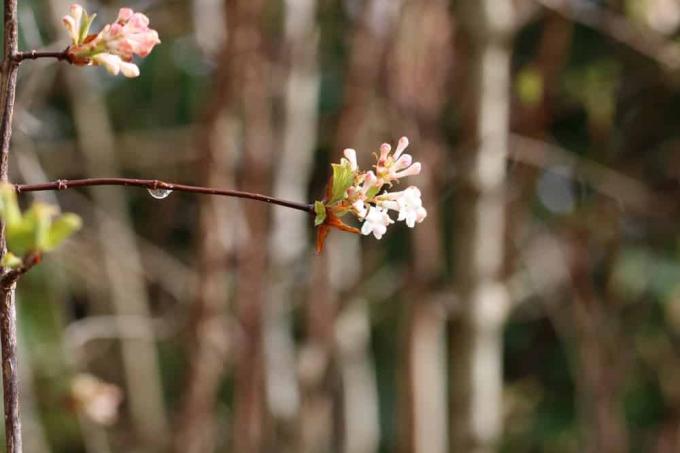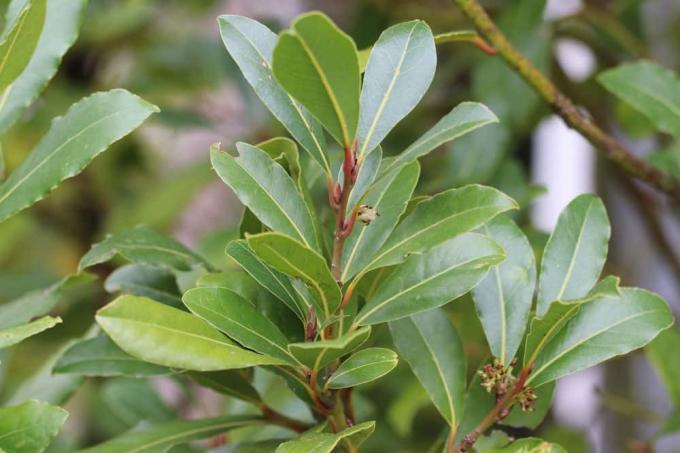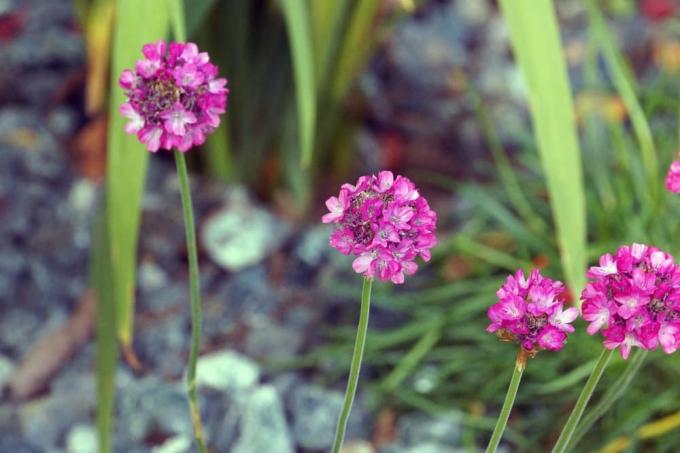

Table of contents
- Location
- substrate
- Pour
- Fertilize
- Cut
- multiply
- hibernate
- particularities
- Care
- Conclusion
Also known as the evergreen scented snowball, the Easter snowball is an early flowering plant with numerous benefits. Strongly fragrant flower panicles and dense growth characterize the shrub and make it an attractive eye-catcher - even in winter. In addition, the plant is quite undemanding and therefore also ideal for beginners among hobby gardeners. In order for the Easter snowball to be able to unfold its full beauty, however, the right care measures and, above all, a suitable location are required.
Location
The plant needs plenty of sun for the white flowers of the Easter snowball. If it is too shady, the flowering power decreases significantly. A location where the evergreen scented viburnum does not have to endure the blazing midday sun is therefore optimal. Especially in winter, this quickly leads to burns on the leaves. The planting site should therefore face east or west or be slightly shaded. The slowly growing Easter snowball reaches a height of 150 to 200 cm, so it needs some space at the top. This should also be considered when choosing the location.
- However, it is important that the soil is particularly rich in nutrients. The soil should be nice and loose. The ground must not accumulate water.
- If you want to plant the evergreen viburnum in heavy clay soil, you should mix it with some sand beforehand.
- As an alternative, you can also plant the Easter snowball in a bucket. They are ideal as an eye-catcher and as a decorative element on your balcony or terrace. However, make sure that the plant gets enough sun.
- The evergreen viburnum can also be used as a grave plant. So you have an evergreen grave planting that rarely needs to be watered.
substrate
The Easter snowball is quite undemanding when it comes to the substrate. Fresh, normal garden soil will do. This should be rich in humus and nutrients, so it is best supplemented with compost. A slightly acidic pH is ideal. However, neutral or slightly alkaline soils are also tolerated.
Tip:
If you want to reduce the maintenance effort for the evergreen scented snowball and at the same time do something good for the shrub, apply a thick layer of mulch to the substrate.
Pour
The Easter snowball thrives best when kept slightly moist at all times. On the other hand, it quickly reacts to waterlogging and drought. Watering is therefore always carried out when the top layer of soil has dried slightly. Alluvial watering should only be done when it is very hot and during long dry periods, otherwise the watering should be kept small. Both tap water and rainwater or untreated pond water are suitable. If the soil is already calcareous, it is better to use soft water. Too much lime can pollute the evergreen scented snowball. If a layer of mulch has been applied to the substrate, watering is rarely necessary.
Fertilize
Since the Easter snowball has an annual increase of just 15 to 20 cm, i.e. it grows slowly, it only has a low nutrient requirement. Nevertheless, it should be lightly fertilized. Organic and natural fertilizers such as plant manure, compost and pond water are suitable for this. These are administered in small amounts every four to eight weeks from spring to late summer. Again, mulch can reduce the effort if spread in a thick layer underneath the evergreen scented viburnum. In this way, it continuously releases nutrients, making additional fertilizing unnecessary.
Cut
After the flowering period, which usually ends in May, the Easter snowball should be thinned out. The slow growth must be taken into account here, so only a little of the shoot length may be removed all around. On the other hand, shoots that are too dense and grow inwards are completely removed. Butts shouldn't stop there.
The pruning is not absolutely necessary for the shrub to thrive, but if it is missing, it quickly becomes noticeable. Young shoots in particular bear the pink buds from which the white flowers develop. The older the branches are, the more the flowering power decreases. Thinning out and slightly correcting the outer area has a rejuvenating effect and promotes flowering. However, the shrub does not have to be shaped.
multiply
The easiest way of propagation is to separate the offshoots, which the evergreen scented snowball develops all by itself. To do this, proceed as follows:
- If there are spurs around the Easter snowball, they should be allowed to reach a height of at least 15 to 20 cm. So be careful when mowing the lawn and weeding.
- When the young shoots have reached the minimum height, they are carefully separated from the mother plant with a spade in late spring or autumn and dug up.
- Freed from the old substrate, they are planted in the desired place and watered well. The application of mulch is recommended as a cover and protection against evaporation.
By the way, you shouldn't wait too long before separating and moving the Easter snowball offshoots. The taller the young plant, the deeper its roots and the risk of damaging the roots of the mature shrub increases.
In addition to propagation via foothills, it is also possible to root cuttings of the evergreen scented viburnum or to form sinkers. Approximately 15 cm long head cuttings are ideally obtained in early autumn and placed in moist soil. For high chances of success, it is advisable to use planters and to set them up in a cool and bright but frost-free place in winter. The substrate is kept slightly moist throughout.

Spring, on the other hand, is the best time for rooting the sinkers. To do this, branches that are as long and flexible as possible are pressed onto the ground and weighed down with a stone at a point close to the mother plant. Direct contact with the moist soil is important. After about four weeks, the stone can be raised and the sinker checked for roots. If these are not yet present, the sinker is weighted down again. If there is a root system, the sinker can be separated from the mother plant with sharp scissors, carefully dug up and transplanted. Again, keeping the substrate moist is important.
hibernate
As the name suggests, the evergreen scented viburnum bears leaves all year round. It is also frost hardy, so you can leave it in the garden in winter without any problems. This also applies if it is cultivated in a bucket. A light protection is still advisable. Mulch and piled-up brushwood work best. Garden fleece should also be wrapped around the planter in the bucket after it has been moved to a sheltered spot. The winter sun in particular can damage the leaves, so a place in the light shade is recommended. However, the Easter snowball must not stand completely darkened. If cuttings were obtained in autumn to propagate the shrub and placed in the ground, they should be allowed to overwinter frost-free. As already mentioned, this increases the chances of successful rooting. These should also be cool, at a maximum of 12 °C and bright. In addition, the substrate should be kept slightly moist.
particularities
- Like the others snowballplant, the Easter snowball is also a poisonous plant.
- Depending on care and location, the Easter snowball can reach a height of about two meters to two meters sixty.
- Thanks to its densely growing branches, the plant is also ideal as a privacy screen, for example for a hedge.
- The only disadvantage is that it takes a very long time before the Easter snowball reaches the desired height.
Care
- Usually it suffices, because evergreen snowball to water every two weeks. So only water when the soil around the plant is very dry.
- You can also do without fertilizing the plant - at least if it is in the ground.
- If you have the plant in a bucket, you can give it a little fertilizer every now and then.
- A pruning of the Easter snowball is not absolutely necessary. If so, then you should do this after flowering.
Tip:
However, keep in mind that the evergreen viburnum can bloom again in the fall. If you cut too much, the second bloom usually fails. In addition, the plants form many offshoots, so that they multiply in no time.
When caring for them, make sure that the plants are not attacked by pests. This is where the snowball beetle comes into play. If this is not recognized and combated in good time, it can eat away at the entire foliage of the plant. In the event of an infestation, it is important to act quickly and fight the beetle with chemical agents.
Conclusion
The Easter Snowball is a decorative plant that requires little care in the right location. The already low effort can be further reduced if mulch is applied regularly. If you cut the shrub every year, you can enjoy the lush and incomparably fragrant flowers for a long time.
 garden editorial
garden editorial I write about everything that interests me in my garden.
Learn more about garden plants - care

Lepidoptera, Faboideae - characteristics and representatives from A-Z
From the tropics to the arctic, legumes colonize our planet with more than 12,000 species. They serve us as ornamental and food plants or annoy us as weeds. Immerse yourself in the fascinating world of butterfly blossom plants. Get to know their characteristics and meet their representatives from A-Z.

Laurel tree has brown leaves - diseases + pests on laurel
If the spice laurel suddenly gets yellow leaves, which then turn brown and possibly fall off, the cause of the disease must be found out. This is the only way to do something against the dying of the laurel tree. In many cases, the plant can be saved quite easily.

Double garden jasmine, chanterelle tree - care, cutting and propagation
A concentrated, delicate white blossom and an enchanting scent characterize the double garden jasmine, which is also known under the name mock orange. It is therefore becoming increasingly popular in local gardens as hedges and privacy screens or as a solitaire. The ornamental tree is very easy to care for and should therefore not be missing in any garden.

Laurel tree, Laurus nobilis - information on care, propagation and wintering
The laurel tree is a popular, evergreen shrub that is suitable for pot culture or also grows in mild locations in the garden. Cared for and neatly cut, the dark green, leathery foliage can provide breathtaking accents in entrance areas or on terraces. You can find out how to properly care for the laurel here.

Thrift, Armeria - Varieties, care and information on winter hardiness/toxicity
Its long flowering period and uncomplicated care make the thrift a popular perennial that knows how to make a brilliant understatement. Where other summer flowers languish in the dry, sunny location, armeria trumps with colorful flowers. Explore the most beautiful varieties, practical care instructions and well-founded information on winter hardiness and toxicity.

Catchfly, Silene viscaria - sowing, planting & care
The pitcher (Lychnis viscaria) is a perennial, bushy wild perennial belonging to the Carophyllaceae family. Since it originally comes from the Mediterranean region, it is suitable for moor gardens, for green roofs, as a hardy garden perennial and as a decorative cut flower. The plant usually flowers from May to August in a strong fire or chimney red and reaches a height of about 40 to 50 cm.
